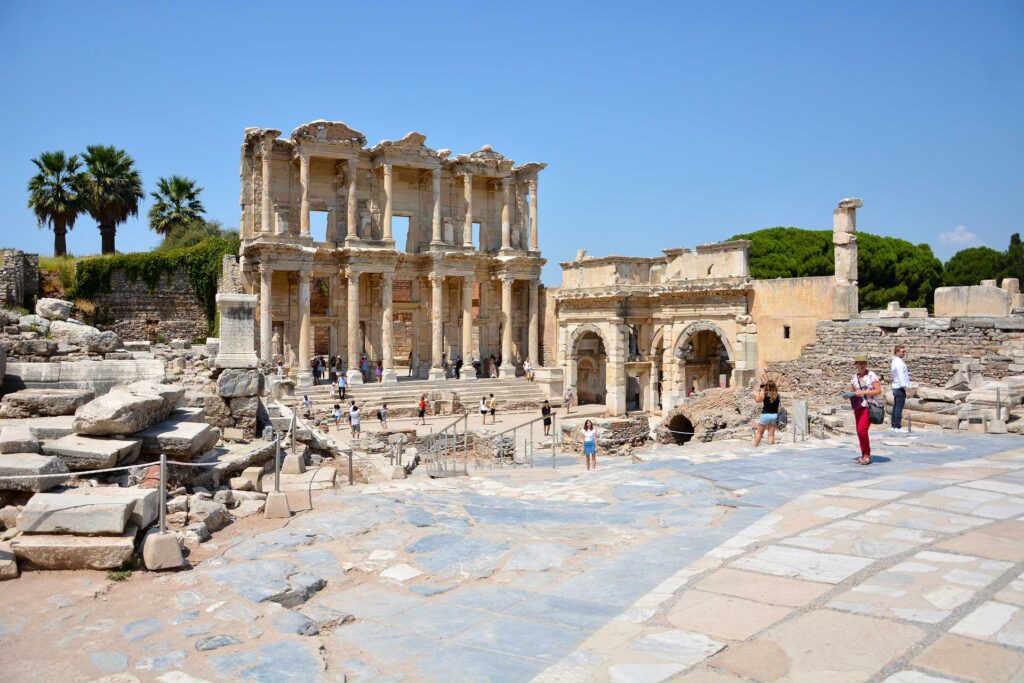Archives
Categories
Meta
-
- Please authorize with your Instagram account here
Ephesus
For we wrestle not against flesh and blood, but against principalities, against powers, against the rulers of the darkness of this world, against a spiritual wickedness in high places. [A Quote from Ephesians]
About Ephesus
Ephesus was a city in ancient Greece on the coast of Ionia, 3 kilometers (1.9 mi) southwest of present-day Selçuk in İzmir Province, Turkey. It was built in the 10th century BC on the site of the former Arzawan capital by Attic and Ionian Greek colonists. During the Classical Greek era, it was one of twelve cities that were members of the Ionian League. The city came under the control of the Roman Republic in 129 BC.
The city was famous in its day for the nearby Temple of Artemis (completed around 550 BC), which has been designated one of the Seven Wonders of the Ancient World. Its many monumental buildings included the Library of Celsus and a theatre capable of holding 24,000 spectators.
Ephesus was also one of the seven churches of Asia cited in the Book of Revelation; the Gospel of John may have been written there, and it was the site of several 5th-century Christian Councils (see Council of Ephesus). The city was destroyed by the Goths in 263. Although it was afterward rebuilt, its importance as a commercial center declined as the harbor was slowly silted up by the Küçükmenderes River. In 614, it was partially destroyed by an earthquake.
Today, the ruins of Ephesus are a favorite international and local tourist attraction, perhaps partly because they are easy to access from Adnan Menderes Airport and from Kuşadası, a cruise ship port some 30 km south of it. In 2015, the ruins were designated a UNESCO World Heritage Site.

Where to See in Ephesus
Temple of Artemis
The Temple of Artemis, one of the Seven Wonders of the Ancient World, once stood 418′ by 239′ with over 100 marble pillars each 56′ high. The temple earned the city the title “Servant of the Goddess”. Pliny tells us that the magnificent structure took 120 years to build but is now represented only by one inconspicuous column, revealed during an archaeological excavation by the British Museum in the 1870s. Some fragments of the frieze (which are insufficient to suggest the form of the original) and other small finds were removed – some to London and some to the Istanbul Archaeology Museums.
Library of Celsus
The Library of Celsus, the façade of which has been carefully reconstructed from original pieces, was originally built c. 125 in memory of Tiberius Julius Celsus Polemaeanus, an Ancient Greek who served as governor of Roman Asia (105–107) in the Roman Empire. Celsus paid for the construction of the library with his own personal wealth and is buried in a sarcophagus beneath it. The library was mostly built by his son Gaius Julius Aquila and once held nearly 12,000 scrolls. Designed with an exaggerated entrance — so as to enhance its perceived size, speculate many historians — the building faces east so that the reading rooms could make the best use of the morning light.
The Odeon
The Odeon was a small roofed theatre[71] constructed by Publius Vedius Antoninus and his wife around 150 AD. It was a small salon for plays and concerts, seating about 1,500 people. There were 22 stairs in the theatre. The upper part of the theatre was decorated with red granite pillars in the Corinthian style. The entrances were at both sides of the stage and reached by a few steps.
Temple of Hadrian
The Temple of Hadrian dates from the 2nd century but underwent repairs in the 4th century and has been reerected from the surviving architectural fragments. The reliefs in the upper sections are casts, the originals now being exhibited in the Ephesus Archaeological Museum. A number of figures are depicted in the reliefs, including the emperor Theodosius I with his wife and eldest son. The temple was depicted on the reverse of the Turkish 20 million lira banknote of 2001–2005 and of the 20 new lira banknote of 2005–2009.
Basilica of St. John
A part of the site, Basilica of St. John, was built in the 6th century, under emperor Justinian I, over the supposed site of the apostle’s tomb. It is now surrounded by Selçuk.
The House of the Virgin Mary
The house was discovered in the 19th century by following the descriptions in the reported visions of Blessed Anne Catherine Emmerich (1774–1824), a Roman Catholic nun and visionary, which were published as a book by Clemens Brentano after her death.[2] While the Catholic Church has never pronounced in favor or against the authenticity of the house, the site has nevertheless received a steady flow of pilgrimage since its discovery. Anne Catherine Emmerich was beatified by Pope John Paul II on October 3, 2004.
Catholic pilgrims visit the house based on the belief that Mary, the mother of Jesus, was taken to this stone house by Saint John and lived there for the remainder of her earthly life.
The shrine has merited several papal Apostolic Blessings and visits from several popes including Paul VI, John Paul II, and Benedict XVI.
Reference: https://en.wikipedia.org/wiki/Ephesus
Ephesus Turkey Package Tours
You may check our Turkey tours including Ephesus by clicking HERE.
Share this tourRelated Tours

$356
Private Daily Ephesus Tour from Istanbul
Temple of Artemis, Library of Celsus, Ephesus Ancient City, The House of Virgin Mary
Winner Local Experts
Travel Tips Turizm is a fully licenced travel agency and an accredited member of TURSAB with licence #9297. Click here to verify.

Contact Info
Popular Destinations


